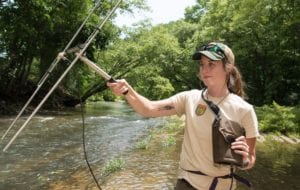The article below ran in the Sunday, June 30 edition of the Charleston Gazette-Mail, a Pulitzer Prize-winning newspaper
PINEVILLE, W.Va. — Standing in the shallows of a rushing mountain stream, Nicole Sadecky held a radio receiver up to her ear and listened for a faint signal.
“I hear one,” she said, gesturing toward a flat rock just under the water’s surface.

She held out the receiver. “Here. Take a listen.” Sure enough, a faint telltale chirp revealed that a transmitter was nearby — a transmitter attached to the inch-long claw of an endangered crayfish.
Sadecky, a graduate student at West Liberty University, has spent the last year wading the shallows of two southern West Virginia streams, tracking the movements of Cambarus veteranus, colloquially known as the Guyandotte crayfish. She hopes her research might someday help get the rare crawdad off the federal Endangered Species List.
The Guyandotte crayfish, once thought extinct, was rediscovered in 2009 by Sadecky’s mentor, West Liberty professor Zac Loughman. Historically, the creature had been found in eight streams, all tributaries to the upper Guyandotte River in Wyoming and Logan counties. Loughman found it at only one site in only one Wyoming County stream, Pinnacle Creek.
Subsequent studies discovered the species’ presence in Clear Fork, another Wyoming County stream a dozen miles to the northwest, but that turned out to be the extent of it. In 2016, the U.S. Fish and Wildlife Service listed C. veteranus as endangered.
“Following that, we really needed to learn more about what sort of habitat the species was using, as well as a little bit about its life history,” Sadecky said.
Having worked alongside Loughman for years as an undergraduate and as a grad student, Sadecky already had a wealth of experience with that particular crayfish. The Ravenswood native also had done field work on the species for the state Division of Natural Resources. Not surprisingly, she chose to expand her work into a master’s thesis project.
“In June 2017, we started a life-history study that’s been ongoing since then,” Sadecky said. “So far, we have more than two years’ worth of life-history information. We’ve kind of learned when the species’ reproduction period is likely happening, when the females are laying their eggs, and we roughly know how large these individuals are growing and how quickly they’re growing.”
Last summer, Sadecky began studying the species’ movements within their environment. To accomplish that, she captured specimens in a net and attached tiny radio transmitters to their claws.
The pea-sized transmitters, which weigh just 1.5 grams, don’t appear to impede the crayfish’s movements. Sadecky said the radios had previously proved effective for tracking the non-endangered New River crayfish, which is similarly sized and uses similar habitat.
“Last July, we put transmitters on five [Guyandotte] crayfish just to see if it was possible,” she said. “It worked, and we were able to recover almost all the crayfish we tracked. This year, we want to dial in and find out how much they are moving and how far they move in a day.”
She tracks four times a day — at 6 a.m., noon, at dusk and at midnight. The data she gathers should tell her how much of the stream’s habitat the radio-equipped crayfish are using, and whether they’re moving actively or sitting still.
“So far, we’ve seen more movement out of the males, which makes sense,” she said. “This is the time of year we think they’re reproducing, so the males are moving to try to find females.”
Sadecky’s habitat work revealed the species prefers to live in the spaces under slab-like boulders where the water flows just swiftly enough to keep sediment from clogging spaces between stones. She said identifying the crayfish’s preferred habitat might eventually aid efforts to reintroduce it to streams where it had been extirpated.
“If we figure out what they need, maybe we can recreate those conditions in other streams and move some veteranus there sometime in the future,” she said.
Sadecky will finish writing her thesis this year, and hopes to defend her research sometime this winter. Afterward, she wants to continue to work with the species.
“I’d like keep working with it, to be involved in restoration and management efforts,” she said. “It was cool to be part of the baseline-data study and part of the [endangered species] listing process, and learning what veteranus is doing in these streams. But I really hope to see it through and be with it at the end as well.”
So, if years from now you see a lanky blonde wading in some remote Guyandotte River tributary, holding what looks like an oversized transistor radio to her ear, you’ll know she’s not rocking out to tunes from her playlist. She’ll be listening to KRAY-FM, the Guyandotte crayfish station.
EDITOR’S NOTE:
Dr. Loughman’s laboratory is one of the few in the country that focuses solely on astacology, the academic study of crayfishes (crayfish biology). To date, Loughman and his students have sampled crayfish in 13 states, and over 3,000 streams across the eastern and central United States.
Also a WLU alumnus, he is a co-director of the new Zoo Science major. For more information on WLU’s College of Sciences, please click here.